What We Know about the Bassett Family of Lynn, Massachusetts
How Capt. William Bassett of Lynn, Massachusetts is my ancestor:
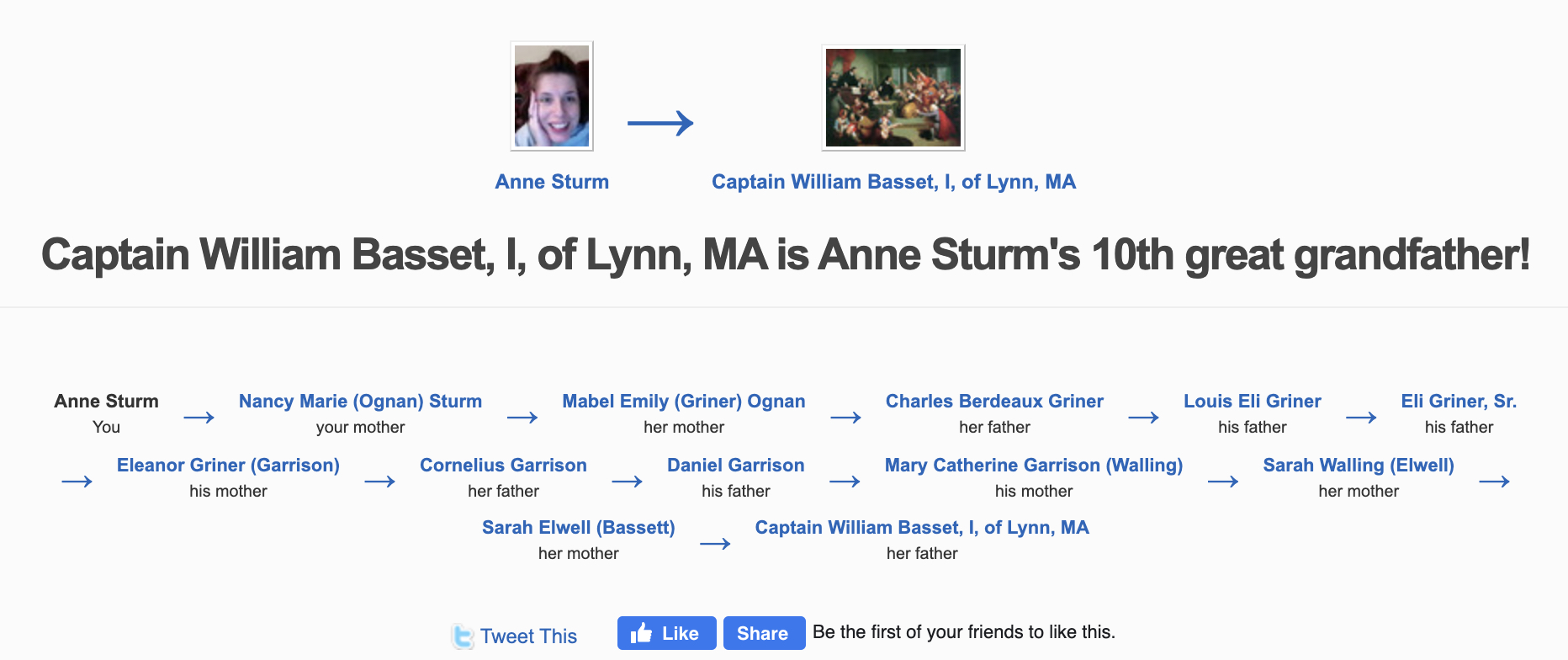
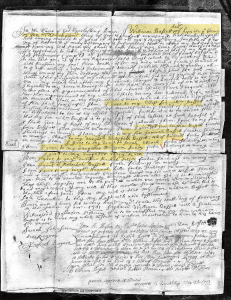

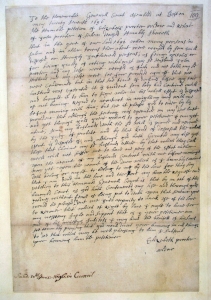



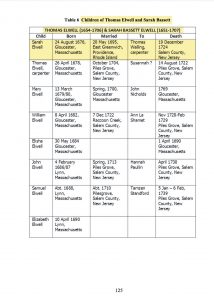

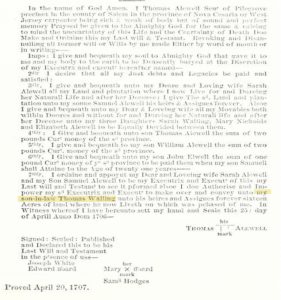
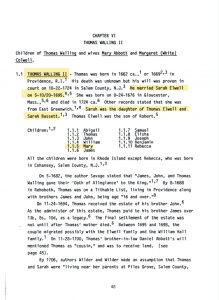
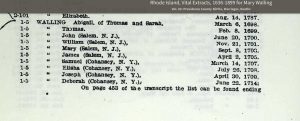


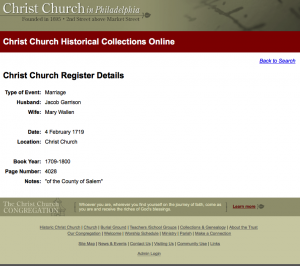

* Noteworthy
Three of the children of William and Sarah Burt Bassett were involved in the Salem Witchcraft Trials that deeply affected their families. Their eldest daughter, Elizabeth, her husband, a step-son, one of her sons, and her daughter, Sarah, were all taken into custody, and the young men were tortured for testimony. Her husband, John Proctor, was hanged and Elizabeth escaped the same fate by virtue of being pregnant . Her brother William’s wife, Sarah Good Bassett, was imprisoned in Boston for several months. Their sister, Mary De Rich was also imprisoned and had the added heartbreak of her only child John testifying against various of the victims after his father and her husband, Michael, died while she was in jail. The Salem Witchcraft trials made memorable history in America, and that period in Salem has been the subject of many writings, films, and Arthur Miller’s well known play The Crucible, which featured (with some liberties) John and Elizabeth Proctor. Two premises of American law stemmed from the series of events in Salem: the concept of innocence until proven guilty; and the concept of cruel and unusual punishment.
An Overview of Their Lives
William Bassett and his wife, Sarah Burt, who was also his step sister, lived their lives in Lynn, Essex County, Massachusetts. One genealogical notation about Sarah Burt is that “proof” she was the Sarah, daughter of Hugh, was based on narrative of their day and cannot be substantiated in any records. William and Sarah had a large family, most all of whom survived to adulthood and populated various areas including Lynn, Marblehead, western New Jersey, and Woburn, Massachusetts.
Several Bassetts immigrated to the colonies in the seventeenth century, and two of these were “Williams” who arrived at about the same time in Massachusetts. All of the early New England Bassetts here are mentioned, because they are sometimes confused with each other — especially the two Williams who arrived in Massachusetts.
1. William Bassett of Plymouth, Massachusetts, who arrived on the Fortune in 1621
2. William Bassett of Lynn, Massachusetts, who arrived on the Abigail in 1635 (my Ancestor)
3. John Bassett of New Haven, Connecticut, who died there in 1652
4. William Bassett of New Haven, Connecticut, who died there in 1684
5. Thomas Bassett of Fairfield, Connecticut, who arrived on the Christian in 1635.
Our William Bassett was born in 1624 in Dorking, Surrey, England to Roger Bassett and his wife Ann Holland Bassett. William’s baptismal certificate is still on file at St. Martin’s Church, which also ascertains the names of his parents. He is the only one of the above-listed Bassetts whose parentage is known (so ignore the lineage to “De Bassetts” and the royal families of England spotted in some user trees). Roger and Ann Bassett were married in St. Martin’s Church, Dorking, County Surrey, England, on 27 Apr 1623. The marriage record still exists there as does the 30 May 1624 baptismal certificate for son William. Genealogists assume he was their only child.
William Bassett was registered (age 9) on 17 Jun 1635 for passage on the ship Abigail, which sailed from England and arrived in Massachusetts later that year. His name appears as the only Bassett on board with his mother Ann Burt, her husband Hugh Burt, and Hugh Burt’s son, Edward (8). Hugh Burt, Jr. at age 15 was registered on 1 July 1635 by Shipmaster Robert Blackwell for the same passage.
The Burt family settled in the Massachusetts Bay Colony, and Hugh Burt’s name appears among the original inhabitants of Lynn, who were given land in 1638. William was given enough education to read and write as evidenced by the signing of his own will and that of Hugh Alley in 1673. His inventory at death also included books.
William married in approximately 1646 a woman named Sarah. According to Lewis and Newhall in the Annals of Lynn, William married Sarah Burt in 1640. However, there is no proof that Hugh Burt had a daughter of this name, and her surname and the year of their marriage are both in question. No record of her baptism exists with those of Hugh Burt’s other children at St. Martin’s Church in Dorking, and her name does not appear among the list of passengers on the Abigail. Hugh Burt refers in his will to “my son Will Bassett”, and refers to no daughters. Nevertheless, many genealogists name his wife as Sarah Burt, daughter of his step-father, Hugh.
There are many records from Lynn, Massachusetts which tell us something of William’s life there. He was active in the community, participated in several real estate transactions, and served in the military, as evidenced by the records abstracted below:
Timeline:
- 01 Jun 1660: William Bassett of Lynn, husbandman [farmer] with the consent of Sarah, his “now wife” sold to Andrew Mansfield, husbandman, three acres of meadow in Lynn
- 1661: Hugh Burt (William’s step father) made extensive provision in his will for “my son Will.” In Hugh Burt’s will, dated 07 Oct 1661: “my son William Bassitt” received two acres of salt marsh, 5 acres of upland, and “my wearing apparel.”
- 24 Jun 1662: William served on the Petit jury.
- 23 Feb 1664: William Bassett of Lynn, husbandman, and Sarah his wife sold to Allen Bread of Lynn, husbandman, two acres of salt marsh in Rumney.
- 29 Nov 1664: William again served on the Petit jury.
- Jun 1666: William was named “Constable” in Lynn.
- 29 Oct 1667: Edward Richards of Lynn, joiner, and Ann his wife sold to William Bassett of Lynn, husbandman, twelve acres
- 20 Feb 1668: Richard Richardson of Lynn, wood cutter, sold to William Bassett of Lynn, husbandman, three acres in Lynn
- 24 Nov 1668: William served again on the Petit jury.
- 28 Jun 1670: William served again on the Petit jury.
- 28 Nov 1671 and 21 Jun 1672: William served on the Essex County grand jury
- 1673: William signed as a witness the will of Hugh Alley.
- Jun 1673: Lynn was elected a Selectman of Lynn. He held this position in the years 1674, 1675, 1677, 1678, 1679, and 16781 as well.
- Jun 1673: William Bassett was appointed the administrator of his mother Ann Burt’s estate, and also served as her guardian.
- 15 Apr 1675: Benjamin Chadwell of Lynn, husbandman, with the consent of Elisabeth his wife, sold to William Bassett of Lynn, husbandman, eight acres of salt marsh in Rumney Marsh.
- 20 Oct 1675: William Bassett is listed as a Sergeant, and on 1 Dec 1675, he is listed in Capt. Joseph Gardner’s company on the expedition against the Narragansett. (The source credits William Sr. with this rank and activity; however, his son William would have been old enough at this time to have been the William Bassett in question although this source does not suggest that the William Bassett named is anyone other than William Bassett, Sr.
- 30 Nov 1675 and 25 Jun 1678: “Sgt. William Bassett” is again listed on the Petit jury.
- 1677: William takes the oath of fidelity (designating him as a “freeman”. This oath is taken again in 1678.
- Jun 1678: Sgt. William Bassett is named on a Committee to lay out a cartway
- 28 Jun 1680: Thomas Wheeler of Sonington, yeoman, sold to William Bassett Sr. of Lynn, yeoman, nine acres of fresh marsh.
- 04 Dec 1680: William serves on the Coroner’s jury.
- 1682: An account of work done on a bridge in Lynn included payment to William Bassett Sr. for “his boat one day.”
- 29 Jun 1682: William Bassett is listed as “Quartermaster”.
- 28 Jun 1682: William Bassett has attained the rank of “Ensign”.
- 25 Nov 1684: William Bassett Sr. against sits on the Essex Grand Jury.
- 04 Jun 1685: The General Court answered a petition by William Bassett and others of Lynn, Reading, Beverly, and Hingham, by granting a tract of land “in the Nipmug country, of eight miles square, for their encouragement and Others that were serviceable to the country in the late Indian War.” (No settlement was made on this grand until in 1728, many of the petitioners were among those granted land at Narragansett Township No. 3, now Amherst, New Hampshire. William Bassett’s grant was claimed by “William Bassett, grandson.”
- 11 Nov 1689: “He was probably the Captain William Bassett who was of a council of war with Major Benjamin Church at Scarborough, Main (Essex Antiquarian 7:77 citing an unknown source).
- 10 Jul 1690: William and Sarah Bassett of Lynn sold to John Bancroft of Lynn three acres of meadow
- 09 Jul 1691: In a deed recorded on this day, William Bassett, Sr. of Lynn, yeoman, and Sarah his wife sold to William Bassett Jr. of Lynn, “his son,” ten acres of land in two parcels in Lynn. This entry indicates that his wife Sarah was still living on this date in 1691.
- 1692: Several family members were accused of witchcraft in Salem.
- 20 Feb 1701: William Bassett wrote and signed his will.
- March 31, 1703: William died in Lynn, at the age of 78. His wife Sarah was still living when William wrote his will on February 10, 1701, but the exact date of her death is unknown.
- 22 May 1703: William Bassett’s will was proved, indicated he had died by this time. The children surviving and listed in his will: sons William, John, Elisha, and Samuel Bassett; daughters Elizabeth Richards, Sarah Elwell, Miriam Sandy (Sandin), Mary Ruck (DeRich), Rachel Selsbee, Rebecca Bassett, and Hannah Lillie
William Bassett died on March 31, 1703 at Lynn, Essex County, Massachusetts. His will was probated on May 22, 1703. “The inventory of the estate of ‘William Basset of Lyn.’ taken 23 April 1703, totaled £110 14s., of which £74 was real estate: ‘one old house, half a barn ” seven acres ” half of land.’ £67 10s.; and ‘one piece of salt marsh lying by the beach.’ £6 10s…”[2,13]
The Salem Witch Trials and The Bassett Family:
Three of William’s adult children (and/or their families) were direct victims of the horrendous travesty of the Salem witch trials that occurred in 1692.
Elizabeth Bassett Proctor’s husband John Proctor, was 20 years or so older than she and a prosperous farmer in the community. In 1668, Proctor obtained a license to operate a tavern, which he named the Proctor Tavern. This new business, which was located on Ipswich Road about half a mile south of the Salem Village boundary, became very lucrative for Proctor and made him a wealthy man. Elizabeth was his third wife, and he brought with him to the household some of the children of his earlier marriages. John had four children with his first wife Martha Giddens, who died in childbirth in 1659, and six with his second wife Elizabeth Thorndike, who died in 1736. Together Elizabeth and John had seven children of their own, one of whom was born while she was in prison after John was hanged.
Elizabeth’s grandmother Ann (Holland) Bassett Burt, a Quaker and a midwife, had been brought up on charges of witchcraft in 1669. As she was not a doctor, but was successful at curing the sick, some people felt she could only have medical skills if she were a witch; one of those who testified against Ann was Phillip Read, a doctor. The Puritans felt there was something “witch like” about Quakers. Could the stigma of being her granddaughter have contributed to Elizabeth’s trials?
The accusations began with a servant in the Proctor household, Mary Warren, who, in March 1692 began to have fits, and saying she saw the specter (ghost) of Giles Corey. John Proctor was dismissive of her claims (as he was of all the accusations) and worked her harder. He felt that witchcraft should be suspected of the bewitched girls themselves and not of the respectable women of the village. His negative reactions to the girls’ accusations caused Elizabeth to become one of the next accused of practicing witchcraft. On March 29, 1692, Abigail Williams and Mercy Lewis again said they were being tormented by Elizabeth’s specter. A few days later, Abigail again complained that Elizabeth was pinching her and tearing at her bowels, and said she saw Elizabeth’s specter as well as John’s.
In April 1692, 31 men from Ipswich, Massachusetts filed a petition attesting to the upstanding character of John and Elizabeth and denying that they had ever seen anything that would indicate they were witches. In May 1692, a similar petition was filed on behalf of John and Elizabeth containing signatures of 20 men & women, including several of the wealthiest landowners of Topsfield, Massachusetts and Salem Village. It questioned spectral evidence, to the Christian lives that John and Elizabeth had led, stated that they “were ever ready to help such as stood in need of their help” and stated that they had no reason to believe they were witches.
On June 2, 1692, a male doctor and several women completed a physical examination of Elizabeth and several of the other accused. They looked for birth defects, moles, or other markings that they believed were a sign that the person was a witch, and found none.
On July 23, Proctor wrote a letter to the clergy of Boston pleading with them to appoint different judges or move the trials to Boston where he felt they would get a fair trial. In his letter, he described the torture used against the prisoners, particularly against his son William, and declared that the accused were innocent victims.*
Reverend Gentlemen, The innocency of our case, with the enmity of our accusers an our judges and jury, whom nothing but our innocent blood will serve, having condemned us already before our trials, being so much incensed and enraged against us by the devil, makes us bold to beg and implore your favourable assistance of this our humble tradition to his excellency, that if possible our innocent blood may be spared, which undoubtedly otherwise will be shed, if the Lord doth not mercifully step in; the magistrates, ministers, juries and all the people in general, being so much enraged and incensed against us by the delusions of the devil, which we can term no other, by reason we know in our own consciences we are all innocent persons. Here are five persons who have lately confessed themselves to be witches, and do accuse some of us being along with them at a sacrament, since we were committed into close prison, which we know to be lies. Two of the five are (Carrier’s sons) young men, who would not confess anything till they tied them neck and heels, till the blood was ready to come out their noses; and it is credibly believed and reported that this was the occasion of making them confess what they never did, by reason the said one had been a witch a month. And another five weeks my son William Proctor, when he was examined, because he would not confess that he was guilty, when he was innocent, they tied him neck and heels till the blood gushed out at his nose, and would have kept him so twenty-four hours, if one, more merciful than the rest, had not taken pity on him, and caused him to be unbound. These actions are very like the popish cruelties. They have already undone us in our estates, and that will not serve their turns without our innocent blood. If I cannot be granted that we can have our trials in Boston, we humble beg that you would endeavour to have these magistrates change, and other’s in their rooms; begging also and beseeching you would be pleased to be here. if not all, some of you, at our trials, hoping thereby you may by means of saving the shedding of our innocent blood. Desiring your prayers to the Lord on our behalf, we rest your poor afflicted servants.
On August 2, 1692, the court met in Salem to discuss the fate of John and Elizabeth and several others. At some point during this time, John wrote his will, but he did not include Elizabeth. Some speculate that he assumed she would be executed along with him. In spite of the petitions and testimonies from friends, both John and Elizabeth were found guilty, and were sentenced to death on August 5, 1692. Elizabeth, who was pregnant at the time, was granted a stay of execution until after the birth of her baby. In May, three of the Proctor’s children, Benjamin, Sarah and William, had also been accused of witchcraft and arrested.*
Eight ministers met to discuss the letter and the fate of the victims, but on August 19, 1692, John was executed along with George Burroughs, John Willard, George Jacobs, Sr., and Martha Carrier and John De Rich, son of Mary Bassett DeRich had testified against Jacobs). As an interesting side note, the Churchills had been driven out of their homes in Maine by the Indians, and some of the accusers had also survived these attacks. PTSD might have been a factor. Elizabeth remained in jail. Action was eventually taken on the petition that John had filed to save his life and that of Elizabeth, but it was too late for John. Elizabeth gave birth to their son, whom she named John III, while still in prison, and by the time he was born, the hysteria had passed. She was released.
Though Elizabeth was free, the ordeal was not over for her, for in the eyes of the law, she had been convicted. The law stated that possessions would be seized when someone was convicted. The Proctors’ possessions had been confiscated long before their trials, and Elizabeth could not claim any of John’s property, some of which had been salvaged by this time. She could not regain her dowry because legally, she no longer existed. Elizabeth petitioned the General Court for reversal of attainder to restore her legal rights. No action was taken for seven years, even though it was now widely accepted that innocent people had been wrongly convicted.
On April 19, 1697, the probate court at Salem ordered the Proctor heirs to give Elizabeth her dowry. On September 22, 1699, Elizabeth married her second husband, Daniel Richards, in Lynn, Massachusetts. The public demanded that the courts apologize, and a written apology was issued on March 18, 1702. In July 1703, an address was made to the General Court requesting the petitions from the families be granted. Finally, action was taken to obtain the reversal of attainder for Elizabeth. The Massachusetts House of Representatives passed a bill formally disallowing spectral evidence, but reversing attainder only for those who had filed petitions. This bill applied to Elizabeth and her husband, plus Rebecca Nurse.
John and Elizabeth Proctor were the central characters in Arthur Miller’s play (and subsequent movie, The Crucible. Miller characterized John Proctor as a man much younger than the 60 that was his true age, and also depicted an affair with the servant who accused them. That servant was very young at the time, and historians doubt the affair. The troubles that came to the Proctors may have come from Hathorne, one of the prosecutors, who had earlier lost a case to Elizabeth’s father, William Bassett. The Proctors are also described in the book The Devil in Massachusetts by Marion Starkey, written in 1949.
William, Jr., the son of William and Sarah Burt Bassett, was married to Sarah Hood. Sarah, like so many of her neighbors, was accused of being a witch in 1692. She was tried at Salem on 21 May 1692 and imprisoned in Boston until 3 December 1692. She gave birth to her son, Joseph, on 15 December, shortly after being released. In addition, she took her 22-month old child (probably Ruth) with her to prison. She named her next daughter “Deliverance” in honor of her freedom. In 1693, she was recompensed £9 for her experience.
The third of William and Sarah Burt Bassett’s children to be affected by the witchcraft lunacy was his daughter Mary, who was married to Michael DeRich. She was tried, and imprisoned, but not sentenced for execution. Her only child, a son, testified against her and others, and her husband died while she was in prison.
After the ordeal of the trials, some of the Bassett family joined or continued in the the Quaker Church, and many of the third generation married into Quaker families.
Citation: Great Migration 1634-1635 A-B (Online database. New EnglandAncestors.org, New England Historic, Genealogical Society, 2008. Originally published as: The Great Migration, Immigrants to New England, 1634-1635. Volume 1, A-B by Robert Charles Anderson, George F. Sanborn, Jr. and Melinda Lutz Sanborn. Boston: New England Historic Genealogical Society 1999.
* History of Massachusetts.org, Rebecca Beatrice Brooks
About the Children
- Elizabeth Bassett married relatively late at age 27 a prosperous yeoman and tavern keeper, John Proctor, who had been twice widowed. He brought to his third marriage the only surviving child of his first wife, Martha Giddens (the first three of this marriage died young). Four of the seven children John had with his second wife Elizabeth Thorndike were still living when he and Elizabeth Bassett married. Her step-children ranged in age from 2 to 15 years of age when she married, and Elizabeth and John Proctor had seven children in the 18 years they were married before he was hanged for witchcraft in August of 1672. Elizabeth gave birth to her final child while in prison several months after her husband’s death. She named him “John” after his father even though her step-son John still survived. Unexpectedly released from prison instead of being executed, Elizabeth had six children who outlived their father, and she was penniless. He had written his will shortly before he died and did not include her, probably assuming she would hang after the birth of their child. Also, legally because of her conviction she was considered a non-entity. Years later, her step children were ordered to return her dowry to her, and she received a small settlement from the Colony along wig a declaration of innocence. She married for a second time a man named Daniel Richards in Lynn in 1699. No records exist for them after this time, and I believe it’s probable they lived as quiet a life as they could after her ordeal.
- William Bassett, Jr. inherited his father’s property in Lynn, married 18-year-old Sarah Hood in 1675, and settled in Lynn. They had five children before the events in 1692 found her imprisoned for witchcraft in Boston from May to December. She had her toddler, Ruth, in prison with her, and if the dates are correct, her son Joseph was born about 12 days after his mother’s release. She named her daughter born in 1695 “Deliverance”, probably in celebration of her release from persecution. An eighth child rounded out the family in 1697.
- Elisha Bassett and his wife, Elizabeth Collins, daughter of John and Abigail Johnson Collins, were married in Lynn and had their first four children there. Soon after the end of the witchcraft trials, they removed their family to Pilegrove, Salem County, New Jersey, a new Quaker community where in 1700 Elisha bought 100 acres on a branch of the Salem River. A family Bible and some land deeds there indicate they may have had at least three other children in New Jersey. His brother, Samuel, and the husband of his sister, Sarah, had bought land there in 1698. Elisha was elected Constable of Salem County in 1705 and retained that office for eight years. He died there at some time after that year, but there are no further records for him nor of Elizabeth, his wife.
- Sarah Bassett married Thomas Elwell (My Ancestors) in Gloucester in Essex County Massachusetts where five of their children have birth records. Son John has a birth record under “Alewell” in Lynn, Thomas Elwell did not purchase land in Essex County, Massachusetts, but Thomas Elwell did buy land in Pilegrove, New Jersey in November 1698. Thomas Alewell left a will in Salem, New Jersey proved in 1707 in which he names his wife Sarah and all the children: Sarah Walling, Mary Nickolds, Elizabeth Alewell, Thomas, William, John, and Samuel Alewell.
- Mary Bassett and her husband Michael De Rich had only one child, their son, John. On 23 May 1692, she was arrested and imprisoned She was sent to prison in Boston for six months, during which time her husband died . Their 16-year-old son, John, perhaps dazed after the loss of his parents, testified against his mother and and others, including the Proctors, and Giles Corey, an old man who died being pressed with stones while asking for more weight rather than confessing to witchcraft. Mary was one of the “lucky” ones to be released. She died in Marblehead in 1712. Nothing exists to record whether she and her son reconciled. He married and had four children, the last being born in Reading, Essex, Massachusetts in 1711. It’s possible he died soon after.
- John Bassett was a cooper and a shoreman. In 1714, he and his brother William purchased 20 acres of “Salt marsh and upland or pine land,” and in 1725, they bought 13 more acres on the Pine River. It’s not certain where he married. His wife’s surname remains unknown.
- Miriam Bassett’s husband was Ephraim Sandin, son of John.
- Rebecca Bassett was mentioned in her father’s will as “Rebecca Bassett” in 1701, when she would have been about 32. No further records of her could be found.
- Rachel Bassett and her husband Ephraim Silsbee settled in Lynn and were the parents of Henary (Henry) Silsbee, the father of Lydia who married Aholiab Diamond of Marblehead, and whose daughter Mary was the famous “Moll Pitcher,” a woman who gained international fame as a clairvoyant. The article about this local legend written by Sidney Perley appears in the documents section.
- Hannah Bassett was the second Hannah born to her parents, who had fairly good luck in raising children to adulthood. (The good luck suffered a bit of a setback with the witchcraft accusations). Hannah married John Lillie, the son of a school teacher in Reading, and they raised their family in Woburn, Massachusetts.
- Samuel Bassett bought 150 acres of land in 1698 in Pilegrove, Salem County, New Jersey in 1698. From that, we assume he joined his brother, Elisha, and sister, Sarah (Elwell) there. He was still living when his father’s will was proved, but we have no further records of them.

